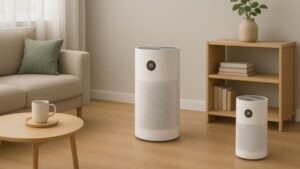7 Simple Ways to Improve Air Quality in Your Home Without an Air Purifier

The air quality in your home is an essential aspect of your overall health and well-being. While outdoor air pollution often captures headlines, the air within our homes can also harbor pollutants that pose health risks. From seasonal allergies and dust to bacteria and mold, these indoor air quality issues can directly affect our comfort and health.
The air quality has deteriorated a lot in urban location due to large scale construction projects and other infrastructure upgrades. This makes it necessary to focus on air quality that we breathe and take steps to improve it to stay healthy.
Air purifiers are a good solution to improving indoor air quality, however they are expensive to purchase and operation. For those not ready to invest in an air purifier or seeking more affordable alternatives, there are effective ways to enhance the air quality in your home without resorting to expensive equipment.
1. Purify Your Air with Houseplants

Incorporating houseplants is a delightful way to not only beautify your space but also improve air quality. Plants like aloe vera, snake plants, peace lilies, and red-edged dracaenas are known for their air-purifying abilities, absorbing volatile organic compounds (VOCs) and releasing oxygen. These natural purifiers also play a role in maintaining humidity levels, helping to prevent mold growth in your home.
2. Weekly Dusting and Cleaning Floors

Maintaining a regular cleaning schedule is crucial for minimizing dust and allergens. Opt for a damp microfiber cloth over a traditional feather duster to trap dust particles effectively. Using a high-quality vacuum cleaner followed by mopping can further reduce dust and allergens on floors, contributing to better indoor air quality.
ALSO READ | Best Water Purifier: A Comprehensive Guide with 7 of the Best Options
3. Ditch Air Fresheners for Essential Oils

Conventional air fresheners often contain VOCs that can degrade air quality. Switching to essential oils used in an aromatherapy diffuser can naturally freshen your home without introducing harmful chemicals. This approach not only improves air quality but also can create a more inviting atmosphere.
4. Use Air Purifying Candles

Consider using candles made from natural materials like beeswax, soy, or coconut oil for their air purifying properties. These candles can help neutralize airborne pollutants, providing a cozy ambiance while improving the air quality in your home.
5. Clean Your A/C Unit Filters

Regularly changing the filters in your air conditioning units is essential for maintaining clean air. Dirty filters can harbor dust, bacteria, and pathogens, negatively affecting the air you breathe. Keeping these filters clean helps ensure the air in your home remains healthy and clean.
6. Remove Footwear When Entering the Home

A significant amount of dust and pollutants can be tracked into the home via footwear. Encouraging household members and guests to remove shoes upon entering can greatly reduce the amount of dust and improve indoor air quality.
7. Open Your Windows

Finally, one of the simplest and most cost-effective ways to enhance air quality is by opening your windows to allow for natural ventilation. Even opening windows for a short period each day can significantly improve indoor air circulation, helping to dilute indoor pollutants. This practice is particularly beneficial in reducing the risk of virus accumulation, including the coronavirus. Before opening windows, it’s advisable to check local air pollution levels to ensure you’re not introducing more pollutants indoors.
Improving the air quality in your home doesn’t require expensive gadgets or complex solutions. By adopting these straightforward strategies, you can create a healthier living environment that benefits everyone in your household.







